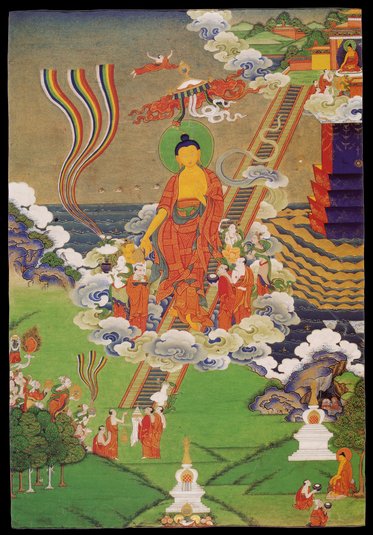November 4 is the 22nd day of the ninth lunar month of the Tibetan calendar. This is the day that we celebrate Lhabab Düchen, one of the four major Buddhist holidays. Lhabab Düchen commemorates Shakyamuni Buddha’s descent from the...
November 4 is the 22nd day of the ninth lunar month of the Tibetan calendar. This is the day that we celebrate Lhabab Düchen, one of the four major Buddhist holidays. Lhabab Düchen commemorates Shakyamuni Buddha’s descent from the Trayastrimsha (Heaven of the Thirty-Three Devas), where he had gone seven years after his enlightenment to offer teachings to his mother, who had died and was residing there.

The story of Shakyamuni Buddha’s descent from Trayastrimsha begins in Tushita. Tushita is a deva-realm or “heaven” that is a part of the same world system as Earth in Buddhist cosmology. It is a realm where practitioners, through dedicated meditation and prayer, can be reborn and receive bodhisattva teachings. It is said that those who receive bodhisattva teachings in Tushita attain enlightenment in their next life. Bodhisattva Svetaketu resided in Tushita before taking birth in the human realm as Siddhartha Gautama and becoming Shakyamuni Buddha. It is said that Bodhisattva Natha currently resides there and, in the future, will be reborn in the human realm and become Maitreya Buddha.
Seven days after giving birth to Siddhartha Gautama (Shakyamuni Buddha), Queen Maya died and took rebirth in the Tushita Heaven. About 35 years into her time in Tushita, Siddhartha Gautama attained enlightenment and became known as Shakyamuni Buddha. Seven years after his enlightenment, seeing that his mother was not able to attain awakening in Tushita, as an expression of his gratitude for all his mother had done for him and to liberate her and all the celestial beings from samsara he wanted to offer Abhidharma teachings to her and the other celestial beings. So, he ascended to Trayastrimsha to offer her these teachings, and Queen Maya traveled from Tushita to Trayastrimsha to meet him there. In Buddhist cosmology, Trayastrimsha is one of the six heavens in the desire realm and is presided over by Indra.
After some months had gone by, the Shakyamuni Buddha’s cousin and close disciple, Anuruddha, perceived that Shakyamuni Buddha was in Trayastrimsha. Missing his teacher, he urged another one of the Buddha’s disciples, Maudgalyayana, to request Shakyamuni that he return to his disciples in the human realm. On the full moon (15th day) of the ninth lunar month, Maudgalyayana debated with Shakyamuni and exhorted him to return. Shakyamuni Buddha agreed and seven days later, on the 22nd day of the ninth lunar month, Indra manifested three ladders that were 80,000 yojanas in length from Trayastrimsha to Sankashya (in modern-day Uttar Pradesh, India.) Shakyamuni Buddha descended the central ladder which was made of precious jewels. Indra descended the ladder on the right which was made of gold and Brahma descended the ladder on the left which was made of silver. While on the ladder, the Buddha performed a miracle. He looked up and in doing so made the god realms visible. Similarly, he then looked down, making the hell realms visible. In that moment, all the beings in the god realms, the human realm, and the hell realms were visible to one another, and all aspired to attain Buddhahood. This miraculous day is commemorated as Lhabab Düchen. Lha translates as “god” and Bab translates as “descend.” Düchen translates as “great occasion.”
In acknowledgment and celebration of this great holy day, Lhabab Düchen, we bring special attention to our dharma practice by engaging in longer periods of ritual and meditation, chanting mantras, making prayers, and making special offerings. We can make offerings of food, flowers, candles, and incense on our shrine/altar at home. We also bring special attention to all our actions of body, speech, and mind so that they are infused with the Four Brahma Viharas of lovingkindness, compassion, joy, and equanimity, as well as the Six Paramitas of generosity, ethical conduct, patience, joyful exertion, concentration, and wisdom as we relate to ourselves, our families, and the world.
It is also an ideal opportunity to make offerings to the teachers and centers that support you on your spiritual journey. On this sacred occasion, the benefit of all dharma practice and beneficial as well as harmful actions is multiplied 10,000,000 times.
Donate now









